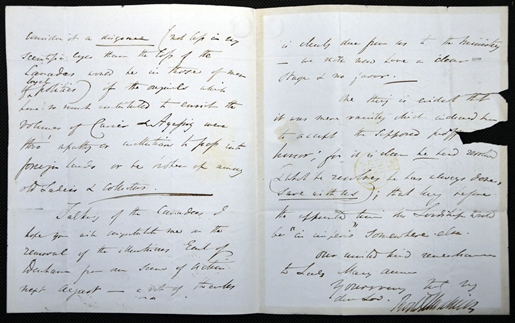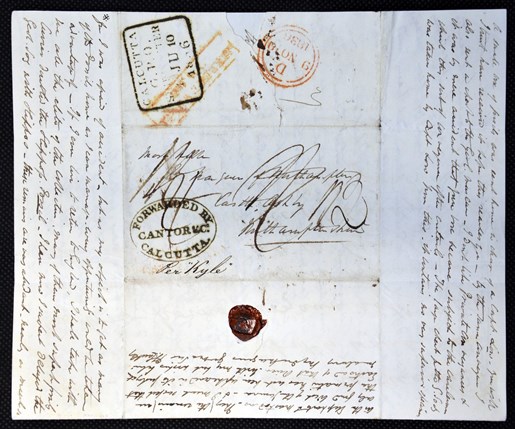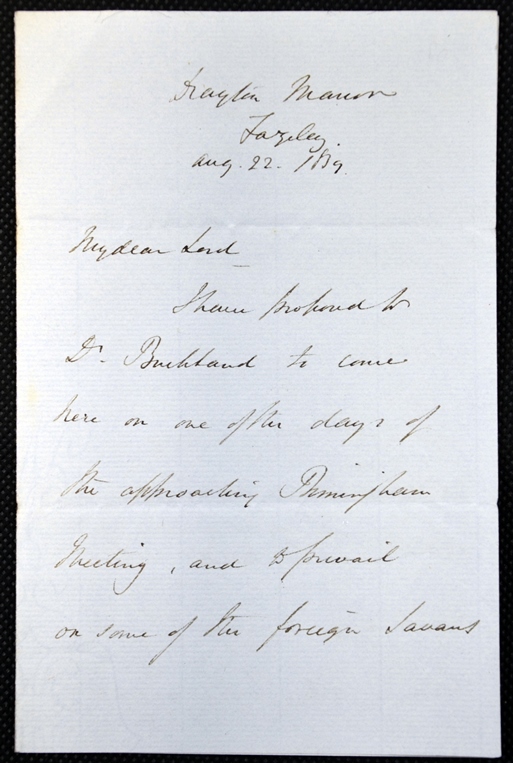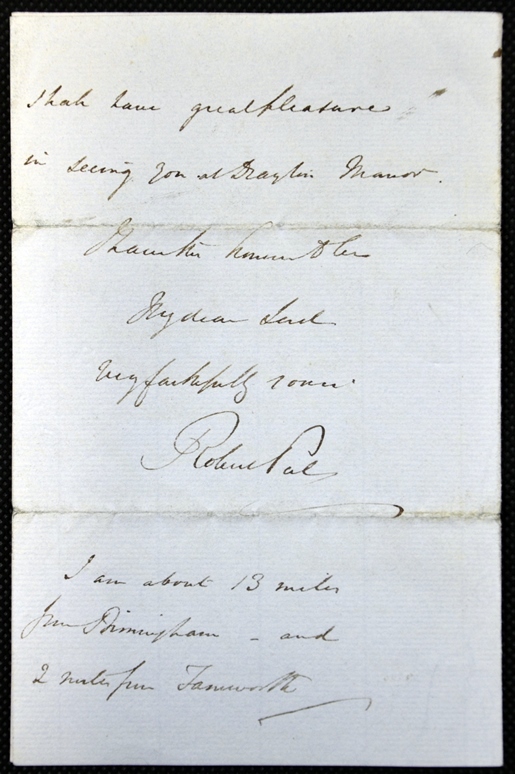Correspondence illuminating the dynamics behind the acquisition of geological collections by public museums in the 19th Century, by Philip Compton*
 Image: Murchison to Compton, January 18 1838.
Image: Murchison to Compton, January 18 1838.
In his role as advocate of the sciences, Spencer Compton (1790-1851) was involved in the acquisition by public bodies of several large and important geological collections. The establishment of these geological collections mainly happened in the last decade or so of his life, by which time he had achieved an extremely prominent position in society, not only as Marquess of Northampton but as President of the Royal Society (1838-1848). He also acted as President for the Geological Society (1820-22), the Archaeological Institute (1845-51), The British Association (1848-49), the Royal Society of Literature (1849-51), and Trustee of the British Museum (1849-51). Upon inheriting his father’s title and wealth in 1828, and becoming a widower after the death of his wife in 1830, he had time and resources to devote to scientific causes.
Compton corresponded with many notable scientists; William Whewell, Adam Sedgwick, Richard Owen, Roderick Murchison, Gideon Mantell, Charles Lyell, Leonard Horner, John Herschel, William Conybeare, Georges Cuvier, William Buckland, David Brewster and Charles Babbage all wrote to Compton. He was also well acquainted with politicians in powerful positions: Three Chancellors of the Exchequer; Henry Goulburn, John Spencer (Viscount Althorp), and Thomas Spring Rice, and five Prime Ministers; Robert Banks Jenkinson (Earl of Liverpool), Arthur Wellesley (Duke of Wellington), William Lamb (Viscount Melbourne), Robert Peel and Lord John Russell. Spencer Perceval was his father’s first cousin and another Prime Minister he would have known. With such excellent contacts and at the interface between politics and academia he was frequently called upon by the early scientists for assistance.
Collections of Fossils
The study of fossils in the early nineteenth century involved either purchasing or rescuing them from quarries and mines in order to preserve and analyse them elsewhere, which resulted in large assemblages. Their interpretation was critical to the formation of wide-reaching theories. It was through the study of fossilized specimens (combined with the biogeographical comparison of finch morphology) that Darwin linked the gradual transmutation of species with existing mammals, to form his theory of evolution by natural selection published in 1859 in his ‘Origin of Species’.
Geologists interpreted fossilized remains with reference to existing floral and faunal morphology, calling upon anatomists and botanists for assistance. In 1842 Richard Owen coined the term dinosaur (translated roughly from the Greek words ‘great’ and ‘lizard’), for the age of saurian creatures which pre-dated mankind, a problematic concept for those adherents to Creationist beliefs, where the world was created by God in six days. Early geologists struggled to reconcile their dating and sequencing of rock formations with accepted Christian belief systems.
Although the early geologists would have theorised over the complex dating of rock formations and the locations of dinosaur fossils within them, natural philosophy is seldom encountered in written correspondences. More transparent are the dealings which occurred surrounding the acquisition, maintenance and display of the collections. This paper focusses on the opaque dynamics behind the acquisition by the British Museum (BM) of three large collections, drawn from letters by academics and politicians to Compton. The collections were transferred in the 1870’s to the purpose-built Natural History Museum, where they are currently housed.
Gideon Mantell’s Collection
 Image: Letter from Cautley in Calcutta, May 31 1836
Image: Letter from Cautley in Calcutta, May 31 1836
Mantell’s studies of fossilized teeth in the 1820’s led to identification of probably the most famous early dinosaur, Iguanodon (named after the iguana on account of anatomically-comparable teeth). His extensive collection was purchased in 1838 by the BM for £4,000. Behind the scenes, Compton was being urged to facilitate this by Roderick Murchison, another of the great early geologists. In a forceful letter from Murchison, dated 18 January 1838, Murchison writes:
“My Dear Lord, your letter of the 14th concerning Mantell’s museum was forwarded to me here where I am detained to attend the funeral of Mrs Murchisons mother who died on Tuesday last at the age of 80.
I have in consequence written as powerful an appeal as I was capable of to Konig [at the BM] which he may make use as occasion presents itself in favour of your very proper suggestion that the Mantellian museum should become national property. In fact I should consider it a disgrace (not less in my scientific eyes than the loss of the Canadas would be in those of men of loyal politics) if the originals which have so much contributed to enrich the volumes of Cuvier and Agassiz were through apathy […] to pass into foreign hands or be broken up among old ladies and collectors.”
The loss of the Canadas compared to the loss of Mantell’s geological collection might seem an extreme comparison, but Murchison’s point is made, furthermore it is clear that he views the purpose of geological collections as being important to the nation and for the benefit of the public, rather than for ‘old ladies and collectors’.
In another letter from 1838, Mantell himself subtly requests that Compton helps with the valuation of his collection:
“Is there any hope of your Lordship visiting Sussex? And if so would you lend your invaluable aid. Dr B thinks there ought not to be less than five [valuers]. Konig and Stutchbury would form two of the committee.”
Konig was Keeper of Natural History at the BM, Stutchbury was another prominent geologist, Dr B is William Buckland. Following his failed attempt at converting his house into a museum, Mantell’s sale of his collection was a desperate measure to raise finance.
Having successfully sold his collection to the BM, Mantell continued to oversee his collection, and how it was housed. He wrote to Compton in 1840, objecting to the proposed dispersal of his collection:
“ My Lord, now that my collection is removed to the British Museum, I am most anxious to preserve […] the chalk from being mixed with the general collection […] it is in fact unique in geology, for where have we another purely fluviantile formation of ancient origin? It is from no personal feeling that I urge this, for all the aspirations after scientific distinction in which I indulged, were destroyed by the loss of my museum. I am obliged to write […] under much mental distress, for my poor child is again worse.”
The sad tone of the letter represents the tragic last fifteen years of Mantell’s life: in 1839 his wife left him, his daughter died in 1840, and in 1841 he fell from his carriage and developed a spinal condition that left him frequently in pain and needing to take opiates in order to sleep. In 1852 he finally died of an opium overdose.
The Cautley Collection
 Images: Right and below - Letter from Peel to COmpton mentioning Buckland at Drayton manor August 22 1839.
Images: Right and below - Letter from Peel to COmpton mentioning Buckland at Drayton manor August 22 1839.
Probably the largest collection Compton became involved with was that of Proby Thomas Cautley, a colonial official sent to India to oversee canal-building projects but with a self-confessed mania for fossil collecting.
In a letter from Saharanpur in 1832, Cautley writes to describe his fossil-collecting experiences:
“ … the most interesting discovery was a petrification of what I in my doubts declared to be a branch of a tree – but the examination of others has gone far to convince me that it is a piece of bone - it certainly bears the appearance of it in texture – but on the discovery of this small specimen, I must confess that I should have diffidence in doing what this might lead to, namely fixing the date of these mountains – and giving them to the time of the Sauria generation”
Cautley sent many boxes of fossils to England, some to Compton for his private collection, others to museums. In May 1836 Cautley writes again, explaining why he makes such an effort to send them back to England:
“I will endeavour to provide Mr Mantells museum with a box of fossils and pray tell me any person to whom you wish that they should be sent and I will see that it is done – a box or boxes shall be sent to the Gardin du plants. The fact is I want to lodge these fossils in museums the curator of which or the manager of which will describe them; as I don’t see the use of entombing them”
In common with Murchison, Cautley desires his fossils to be studied and openly available to the public. By describing them, it is hoped they will be useful to the advancement of science, and the study of mysterious creatures of the past. Cautley perfectly comprehends the type of information that can be gained from the study of fossils:
“I have every intention of giving the most perfect collection that I possibly can to the London Geol. Society, as from that Society we are more likely to receive good descriptions, and the purposes are made of them, than if they were scattered about in private museums […] it is more than possible that we shall be able to add much to fossil Zoology – We have already some 3 or 4 new genera […] I last year sent home 3 chests – this year I have sent home 5 more to the Geol. Soc – the 4 last consisting almost entirely of Hippopotamus”
Two years later, in July 1838, Cautley again writes to Compton, explaining some of the problems he is facing with regard to housing his collections:
“Lord A [Aukland] however called upon the officials for a report which I sent him, and according to the views therein expressed, […] in the event of the Geol Socty. not taking them, that they should go to the British Museum and this of Leadenhall Street – the collection consist of from 3 to 400 large chests – the only thing that I want, is that the Socty taking them should be at all expenses from my house […] all previous expenses I gladly give up”
 Lord Aukland (George Eden), was in the powerful position of Governor General of India 1836-1842. He became involved not only in organising the transportation of the vast collection, but also in securing funding for the publication of a book on Cautley’s fossils by the natural scientist Dr Hugh Falconer. Eden’s problem was that the proposed publishers (Messrs Smith and Elder), agreed to publish Falconer’s book but only on the assurance of the sale of 100 copies. In October 1844 Eden explains the situation to Compton:
Lord Aukland (George Eden), was in the powerful position of Governor General of India 1836-1842. He became involved not only in organising the transportation of the vast collection, but also in securing funding for the publication of a book on Cautley’s fossils by the natural scientist Dr Hugh Falconer. Eden’s problem was that the proposed publishers (Messrs Smith and Elder), agreed to publish Falconer’s book but only on the assurance of the sale of 100 copies. In October 1844 Eden explains the situation to Compton:
“…we wrote to the Court of Directors [of the East India Company], preparing them to adopt the work, and we sent copies of our letter to sir Robert Peel, Lord Ripon, and the Trustees of the British Museum – the Court of Directors, in answer, expressed themselves favourably, but did not take upon themselves the parentage and patronage of the undertaking in the ready and unqualified manner which I could have desired – upon the assumption that the government and the museum will do their parts, they are willing to take forty copies, and to give us the services of Dr Falconer. Sir Robert Peel, for the Government, will take forty copies – but cannot pledge himself upon the part to be taken by the British Museum and the British Museum can do nothing without money. And the difficulties of money cannot be removed before the next meeting of parliament. […] will the trustees of the museum also patronise it, and ask the government for the money necessary to its prosecution […] we can only […] make such representations to them as are likely to have weight – […] I shall be anxious to confer with you upon the best manner of doing this. From your position in the museum, as well as at the Head of the Royal Society, you are likely to be able very materially to help us.”
Evidently Compton and Eden’s efforts were successful, as they managed to secure the purchase of 80 copies, half by the government (under Robert Peel) on behalf of the BM, the other by the East India Company. At the time Peel, apart from being Prime Minister (1841-1846), was also a trustee of the BM, and it is in this capacity in which he would have been contacted by Compton to finance the publication.
The Hawkins Collection
The third major collection was that of Thomas Hawkins, a fossil collector. It proved to be highly controversial at the time. The story of the initial acquisition and valuation has been well documented, whereby Thomas Hawkins sold his collection to the BM in 1834. Consequently it emerged that many of the excellent specimens of fossils had been patched together by Hawkins in an effort to portray the specimens better. Large parts were replicas, and these were indistinguishable from the actual fossils. The issue was brought to the fore by Konig, who demonstrated (by inserting a scalpel into the bones), which ones were real and which were fake. The implication was that Mantell and Buckland, valuers of the collection, had been duped. They in turn had advised the Trustees of the BM to buy the collection. The resolution was to paint the replica bones, and have the subject reviewed by a parliamentary committee.
In letters from Buckland to Compton, their roles in the saga become apparent. On at least two occasions, Buckland writes about Hawkins, extolling his virtues both as an expert collector and as patient recipient of the BM’s late payment for the collection. On 7 April 1839, five years after the initial purchase of the collection, Buckland writes:
“… I shall be in town to attend The Club Tuesday and shall rejoice to meet your Lordship at the Geol. Soc. Club this Wednesday and to accompany you to inspect Mr Hawkins Collection Thursday morning. […] I am glad to say Hawkins has consented to the postponement of payment still another year which will most facilitate the matter in this year of extraordinary repairs at the museum. With respect to Mr Hawkins 2nd collection your Lordship seems to imagine that it is chiefly from Lyme [Regis]. This is not so the specimens at least all the best, are from Street near Glastonbury near the residence of Mr Hawkins.”
The following April (1839) Buckland writes:
“I have written a letter to the Chancellor of the Exchequer. [Thomas Spring Rice 1835-1839]. It states that Mr Hawkins is willing to wait till next year for payment […]. Meantime it may forward the matter, if your Lordship should have opportunity of stating to Mr Spring Rice your opinion of the value and importance of the collection in question, founded on your own personal examination and on the opinions expressed by the highest of all authorities upon such a subject Mr Owen.”
Owen famously catalogued Darwin’s collection of fossils from his Beagle voyage, but here his name is being used to provide weight to Buckland’s argument that Hawkins’ fossils are valuable. Both Hawkins’ collections were eventually purchased by the BM, but only after protracted negotiations. Again, Compton was being called upon for assistance, using his powerful position as acquaintance of Spring Rice to expedite financing of expensive collections.
Compton’s Purpose
Unfortunately the family archives do not contain Compton’s own letters, and we cannot be sure exactly to what extent he is responsible for assuring the purchase of the three collections. However he was in the pivotal position of being respected by politicians, whilst being aware of the importance at a profound theoretical level of the fossils which were accumulating in private collectors’ hands. How he saw his role is evident in an address he made as President of the Royal Society in 1846:
“…our true glory must be found in our scientific utility”.
If he saw his aim as being of scientific utility, then he achieved this outcome, as his machinations appear to have been successful. The result was the comprehensive acquisition of large collections which have sparked the imagination of many a critical thinker of the nineteenth and twentieth centuries. The letters provide a rare insight into the social dynamics behind transactions of objects which were integral to the formation of the natural sciences at a time when they were emerging as separate disciplines. They evince the dependency of public museums on government finance, decisions made by politicians in powerful positions, and the sums involved reflect the importance the politicians attributed to the emerging sciences, and their role in society.
Acknowledgement
I should like to thank the current Marquess of Northampton, Spencer Compton, for allowing me the use of his private archives and sponsoring my research.
Bibliography
Marquis of Northampton [Compton, S.,] 1843-1850, Abstracts of the Papers Communicated to the Royal Society of London, Vol.5: 632-655
* Philip Compton is archive researcher for the Marquess of Northampton. Read more by Philip Compton